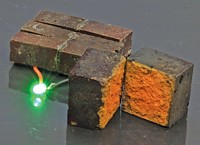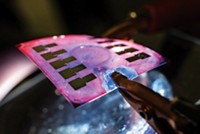Advertisement
Grab your lab coat. Let's get started
Welcome!
Welcome!
Create an account below to get 6 C&EN articles per month, receive newsletters and more - all free.
It seems this is your first time logging in online. Please enter the following information to continue.
As an ACS member you automatically get access to this site. All we need is few more details to create your reading experience.
Not you? Sign in with a different account.
Not you? Sign in with a different account.
ERROR 1
ERROR 1
ERROR 2
ERROR 2
ERROR 2
ERROR 2
ERROR 2
Password and Confirm password must match.
If you have an ACS member number, please enter it here so we can link this account to your membership. (optional)
ERROR 2
ACS values your privacy. By submitting your information, you are gaining access to C&EN and subscribing to our weekly newsletter. We use the information you provide to make your reading experience better, and we will never sell your data to third party members.
Materials
'Artificial Leaf' Produces Electricity
A water-based gel impregnated with photosensitive molecules serves as a new type of biomimetic solar cell
by Stephen K. Ritter
October 4, 2010
| A version of this story appeared in
Volume 88, Issue 40

A water-based gel impregnated with photosensitive molecules and capped by electrodes effectively serves as an “artificial leaf,” mimicking a photosynthesis matrix to produce electricity (J. Mater. Chem., DOI: 10.1039/c0jm01820a). This biologically inspired class of “soft matter” photovoltaic devices, created by Hyung-Jun Koo and Orlin D. Velev of North Carolina State University and coworkers, is a potential low-cost, green alternative to silicon-based solar cells. The researchers first made a hydrogel from agarose, a natural polysaccharide typically used as a substrate in gel electrophoresis. They then added a combination of the photosensitive ionic dyes 9,10-dimethoxy-2-anthracenesulfonic acid and ruthenium trisbipyridine to capture light. The team showed that, when infused in the gel, natural molecules such as the plant pigment chlorophyll and the light-absorbing enzyme photosystem II generate electricity as well. The dye-containing gel was layered on a copper foil electrode coated with carbon black and graphite, which the researchers found to be an inexpensive substitute for a standard platinum electrode. They topped the gel with an indium tin oxide-coated plastic substrate, which served as the other electrode. The prototype biomimetic devices still require significant fine-tuning to improve efficiency and long-term stability, Velev says.




Join the conversation
Contact the reporter
Submit a Letter to the Editor for publication
Engage with us on Twitter